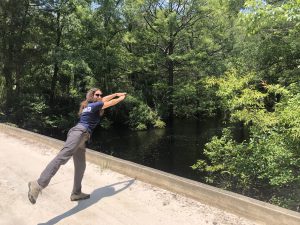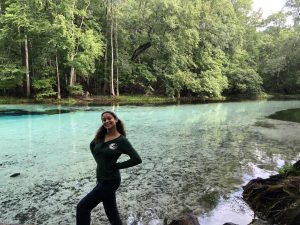Written by 2023 Undergraduate Intern Mikayla Lindenfeld, hosted by the Suwannee River Water Management District
The District 
Whether you’ve floated down a crystal-clear spring run or watched a manatee and its calf swim by your kayak in a river, you’ve probably been in awe of the beauty of Florida’s ecosystems. The health and diversity of precious water resources like the ones you’ve visited are sensitive. The purpose of the Suwannee River Water Management District (the District) is to protect the rivers, wetlands, springs, and underground aquifer in fifteen counties in central-north Florida and beyond. Employees of the District use many fields of science to simultaneously protect water bodies and meet the public need for safe water use. The District permits the use of the land and bodies of water while encouraging residents to remain environmentally conscious. Employees manage hundreds of data collection sites, studying aquifer levels, rainfall, water flow measurements, water quality, and much more. Technology is used to its full potential to improve understanding of the natural resources within the District.


The Water Quality Division
During my internship with the District, I had the privilege of working under Stephanie Armstrong, Katie McBride, and Susie Hetrick in the Water Resources division, among others. Florida is home to the largest concentration of freshwater springs on the planet. While at the District, I was honored to visit many of them. I learned about the upkeep of continuous monitoring sites at springs such as Ichetucknee Head Spring and Gilchrist Blue Spring. I learned how to analyze the data collected to determine the health of the spring. I explored in-house computer programs and mapping software, such as GIS. I identified rare plant species and common types of algae. I learned how a water quality lab is used, including the calibration of probes. I shadowed wetland health assessments, looking for any detrimental impacts on the ecosystem. I was exposed to long-term research projects occurring on the Suwannee River. I was introduced to the other environmental protection groups within the state of Florida. These experiences, and countless more, will be extraordinarily beneficial to my future education and career as a scientist.
 My Nitrogen Probe Comparison Project
My Nitrogen Probe Comparison Project
While shadowing various divisions, I began working on a project to identify the more beneficial nitrate probe for the District to use at their continuous monitoring stations. Deployed at the District’s station in Ichetucknee Springs are a SUNA V2 and a YSI NitraLED probe. Using data collected from that station, I compared each probe’s accuracy, expenses, relationship with spring run turbidity, and staff labor. Using the District’s databases to interpret water quality results, I found that the SUNA V2 was most accurate and was unaffected by increased turbidity. The NitraLED was found to be less expensive over a ten-year period and easier to manage, using fewer employee hours. I concluded that reporting the most accurate results possible is the most important parameter in selecting a device, so the SUNA V2 is the most reasonable nitrate probe for the District at this time.
I had the most amazing summer with the Suwannee River Water Management District. Thank you to everyone who helped me learn and grow.
Learn more about the SRWMD here.

| Follow the link to learn more about the UF/IFAS NCBS Undergraduate Summer Internship program. Read more intern blogs here. |
 3
3
